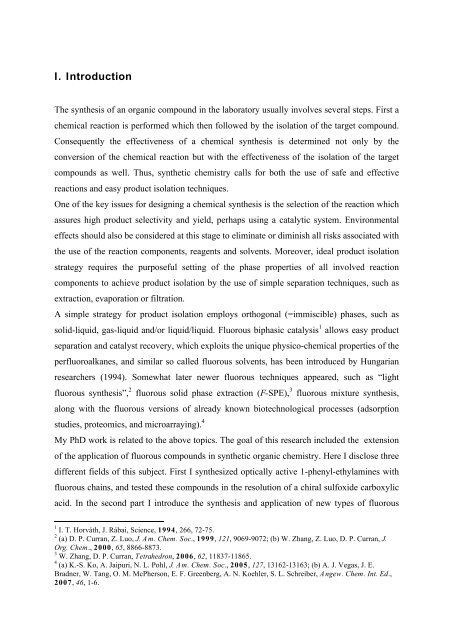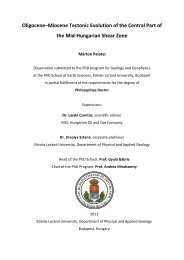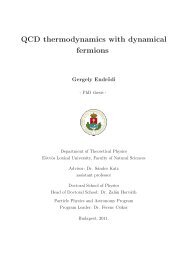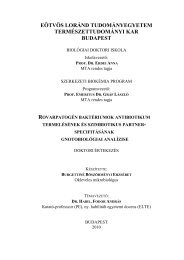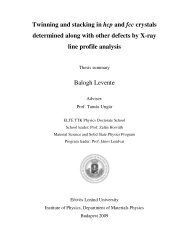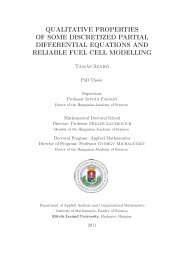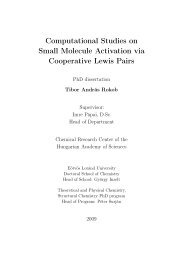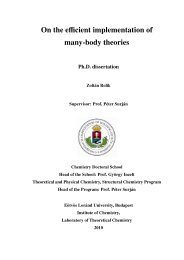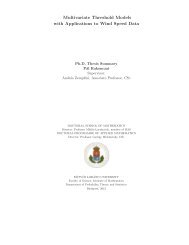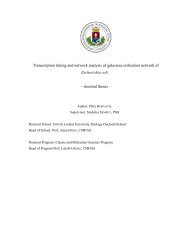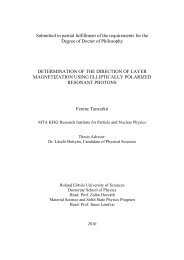Synthesis and application of new fluorinated ... - ELTE TTK TEO
Synthesis and application of new fluorinated ... - ELTE TTK TEO
Synthesis and application of new fluorinated ... - ELTE TTK TEO
Create successful ePaper yourself
Turn your PDF publications into a flip-book with our unique Google optimized e-Paper software.
I. Introduction<br />
The synthesis <strong>of</strong> an organic compound in the laboratory usually involves several steps. First a<br />
chemical reaction is performed which then followed by the isolation <strong>of</strong> the target compound.<br />
Consequently the effectiveness <strong>of</strong> a chemical synthesis is determined not only by the<br />
conversion <strong>of</strong> the chemical reaction but with the effectiveness <strong>of</strong> the isolation <strong>of</strong> the target<br />
compounds as well. Thus, synthetic chemistry calls for both the use <strong>of</strong> safe <strong>and</strong> effective<br />
reactions <strong>and</strong> easy product isolation techniques.<br />
One <strong>of</strong> the key issues for designing a chemical synthesis is the selection <strong>of</strong> the reaction which<br />
assures high product selectivity <strong>and</strong> yield, perhaps using a catalytic system. Environmental<br />
effects should also be considered at this stage to eliminate or diminish all risks associated with<br />
the use <strong>of</strong> the reaction components, reagents <strong>and</strong> solvents. Moreover, ideal product isolation<br />
strategy requires the purposeful setting <strong>of</strong> the phase properties <strong>of</strong> all involved reaction<br />
components to achieve product isolation by the use <strong>of</strong> simple separation techniques, such as<br />
extraction, evaporation or filtration.<br />
A simple strategy for product isolation employs orthogonal (=immiscible) phases, such as<br />
solid-liquid, gas-liquid <strong>and</strong>/or liquid/liquid. Fluorous biphasic catalysis 1 allows easy product<br />
separation <strong>and</strong> catalyst recovery, which exploits the unique physico-chemical properties <strong>of</strong> the<br />
perfluoroalkanes, <strong>and</strong> similar so called fluorous solvents, has been introduced by Hungarian<br />
researchers (1994). Somewhat later <strong>new</strong>er fluorous techniques appeared, such as “light<br />
fluorous synthesis”, 2 fluorous solid phase extraction (F-SPE), 3 fluorous mixture synthesis,<br />
along with the fluorous versions <strong>of</strong> already known biotechnological processes (adsorption<br />
studies, proteomics, <strong>and</strong> microarraying). 4<br />
My PhD work is related to the above topics. The goal <strong>of</strong> this research included the extension<br />
<strong>of</strong> the <strong>application</strong> <strong>of</strong> fluorous compounds in synthetic organic chemistry. Here I disclose three<br />
different fields <strong>of</strong> this subject. First I synthesized optically active 1-phenyl-ethylamines with<br />
fluorous chains, <strong>and</strong> tested these compounds in the resolution <strong>of</strong> a chiral sulfoxide carboxylic<br />
acid. In the second part I introduce the synthesis <strong>and</strong> <strong>application</strong> <strong>of</strong> <strong>new</strong> types <strong>of</strong> fluorous<br />
1 I. T. Horváth, J. Rábai, Science, 1994, 266, 72-75.<br />
2 (a) D. P. Curran, Z. Luo, J. Am. Chem. Soc., 1999, 121, 9069-9072; (b) W. Zhang, Z. Luo, D. P. Curran, J.<br />
Org. Chem., 2000, 65, 8866-8873.<br />
3 W. Zhang, D. P. Curran, Tetrahedron, 2006, 62, 11837-11865.<br />
4 (a) K.-S. Ko, A. Jaipuri, N. L. Pohl, J. Am. Chem. Soc., 2005, 127, 13162-13163; (b) A. J. Vegas, J. E.<br />
Bradner, W. Tang, O. M. McPherson, E. F. Greenberg, A. N. Koehler, S. L. Schreiber, Angew. Chem. Int. Ed.,<br />
2007, 46, 1-6.


